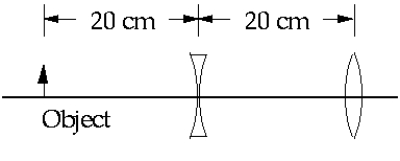 A lens with a negative focal length of -10.0 cm is on the same axis as a lens with a positive focal length of +20.0 cm as illustrated. The distance between the lenses is 20.0 cm. A real object 3.00 cm high is placed 20.0 cm to the left of the first lens. After the light has passed through both lenses, the final image is
A lens with a negative focal length of -10.0 cm is on the same axis as a lens with a positive focal length of +20.0 cm as illustrated. The distance between the lenses is 20.0 cm. A real object 3.00 cm high is placed 20.0 cm to the left of the first lens. After the light has passed through both lenses, the final image is
Definitions:
Mammalian Primate Biology
The study of the biological aspects, characteristics, and behaviors of primates, which are a group of mammals that includes humans, monkeys, and apes.
Behavioral Patterns
Repeated actions or responses by individuals or groups, which are often indicative of underlying social norms, beliefs, or psychological states.
Endangered
Refers to species that are at risk of extinction due to a drastic decline in population and habitat loss.
Q5: Which of the following statements about antiparticles
Q15: A concave spherical mirror can produce which
Q19: Which of the following can influence ethical
Q32: The word isotopes describes elements that have<br>A)
Q36: The radius of the orbit of an
Q38: Isolated magnetic poles<br>A) are readily available in
Q40: <img src="https://d2lvgg3v3hfg70.cloudfront.net/TB7291/.jpg" alt=" The graph shows
Q60: If the work function of thoriated tungsten
Q65: A concave diverging) lens can produce an
Q141: <img src="https://d2lvgg3v3hfg70.cloudfront.net/TB7291/.jpg" alt=" The graph shows